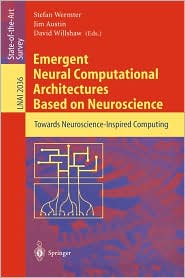Books and Special Issues
Emergent Neural Computational Architectures based on NeuroscienceStefan Wermter, Jim Austin, David WillshawMarch 2001, Springer, HeidelbergISBN: 3-540-42363-X, DM 118,00, 577 pp. Softcover |

|
|
This book is the result of a series of International
Workshops organised by the EmerNet project on Emergent
Neural Computational Architectures based on Neuroscience
sponsored by the Engineering and Physical Sciences
Research Council (EPSRC). The overall aim of the book is
to present a broad spectrum of current research into
biologically inspired computational systems and hence
encourage the emergence of new computational approaches
based on neuroscience. It is generally understood that
the present approaches for computing do not have the
performance, flexibility and reliability of biological
information processing systems. Although there is a
massive body of knowledge regarding how processing occurs
in the brain and central nervous system this has had
little impact on mainstream computing so far. The process of developing biologically inspired computerised systems involves the examination of the functionality and architecture of the brain with an emphasis on the information processing activities. Biologically inspired computerised systems address neural computation from the position of both neuroscience, and computing by using experimental evidence to create general neuroscience-inspired systems. The book focuses on the main research areas of modular organisation and robustness, timing and synchronisation, and learning and memory storage. The issues considered as part of these include: How can the modularity in the brain be used to produce large scale computational architectures? How does the human memory manage to continue to operate despite failure of its components? How does the brain synchronise its processing? How does the brain compute with relatively slow computing elements but still achieve rapid and real-time performance? How can we build computational models of these processes and architectures? How can we design incremental learning algorithms and dynamic memory architectures? How can the natural information processing systems be exploited for artificial computational methods? |
|
|
|
|
Chapters
Towards Novel Neuroscience-inspired Computing (Abstract) Full Chapter (PS) Full Chapter (PDF)Stefan Wermter, Jim Austin, David Willshaw and Mark Elshaw
Modular Organisation and Robustness
Images of the Mind: Brain Images and
Neural Networks
John Taylor
Stimulus-Independent Data Analysis
for fMRI
Silke Dodel, J. Michael Herrmann and Theo Geisel
Emergence of Modularity within One
Sheet of Neurons: A Model Comparison
Cornelius Weber and Klaus Obermayer
Computational Investigation of
Hemispheric Specialization and Interactions
James Reggia, Yuri Shkuro and Natalia Shevtsova
Explorations of the Interaction
between Split Processing and Stimulus Types
John Hicks and Padraic Monaghan
Modularity and Specialized Learning:
Mapping Between Agent Architectures and Brain Organization
Joanna Bryson and Lynne Andrea Stein
Biased Competition Mechanisms for
Visual Attention in a Multimodular Neurodynamical System
Gustavo Deco
Recurrent Long-Range Interactions in
Early Vision
Thorsten Hansen, Wolfgang Sepp and Heiko Neumann
Neural Mechanisms for Representing
Surface and Contour Features
Thorsten Hansen and Heiko Neumann
Representations of Neuronal Models
using Minimal and Bilinear Realisations
Gary Green, Will Woods and S. Manchanda
Collaborative Cell Assemblies:
Building Blocks of Cortical Computation
Ronan Reilly
On the Influence of Threshold
Variability in a Mean-field Model of the Visual Cortex
Hauke Bartsch, Martin Stetter and Klaus Obermayer
Towards Computational Neural Systems
Through Developmental Evolution
Alistair Rust, Rod Adams, Stella George and Hamid Bolouri
The Complexity of the Brain:
Structural, Functional and Dynamic Modules
Péter Érdi and Tamás Kiss
Timing and Synchronisation
Synchronisation, Binding and the
Role of Correlated Firing in Fast Information Transmission
Simon Schultz, Huw Golledge and Stefano Panzeri
Segmenting State into Entities and
its Implication for Learning
James Henderson
Temporal Structure of Neural
Activity and Modelling of Information Processing in the Brain
Roman Borisyuk, Galina Borisyuk and Yakov Kazanovich
Role of the Cerebellum in Time-Critical
Goal-Oriented Behaviour: Anatomical Basis and Control Principle
Guido Bugmann
Locust Olfaction Synchronous
Oscillations in Excitatory and Inhibitory Groups of Spiking
Neurons
David Sterratt
Temporal Coding in Neuronal
Populations in the Presence of Axonal and Dendritic Conduction
Time Delays
David Halliday
The Role of Brain Chaos
Péter András
Neural Network Classification of
Word Evoked Neuromagnetic Brain Activity
Ramin Assadollahi and Friedemann Pulvermüller
Simulation Studies of the Speed of
Recurrent Processing
Stefano Panzeri, Edmund Rolls, Francesco Battaglia and Ruth Lavis
Learning and Memory
Storage
The Dynamics of Learning and Memory:
Lessons from Neuroscience
Michael Denham
Biological Grounding of
Recruitment Learning and Vicinal Algorithms in Long-term
Potentiation
Lokendra Shastri
Plasticity and Nativism: Towards a
Resolution of an Apparent Paradox
Gary Marcus
Cell Assemblies as an Intermediate
Level Model of Cognition
Christian Huyck
Modelling Higher Cognitive Functions
with Hebbian Cell Assemblies
Marcin Chady
Spiking Associative Memory and Scene
Segmentation by Synchronization of Cortical Activity
Andreas Knoblauch and Günther Palm
A Familiarity Discrimination
Algorithm Inspired by Computations of the Perirhinal Cortex
Rafal Bogacz, Malcolm Brown and Christophe Giraud-Carrier
Linguistic Computation with State
Space Trajectories
Hermann Moisl
Robust Stimulus Encoding in
Olfactory Processing: Hyperacuity and Efficient Signal
Transmission
Tim Pearce, Paul Verschure, Joel White and John Kauer
Finite-State Computation in Analog
Neural Networks: Steps Towards Biologically Plausible Models?
Mikel Forcada and Rafael Carrasco
An Investigation into the Role of
Cortical Synaptic Depression in Auditory Processing
Sue Denham and Michael Denham
The Role of Memory, Anxiety and
Hebbian Learning in Hippocampal Function: Novel Explorations in
Computational Neuroscience and Robotics
John Kazer and Amanda Sharkey
Using a Time-Delay Actor-Critic
Neural Architecture with Dopamine-like Reinforcement Signal for
Learning in Autonomous Robots
Andrés Pérez-Uribe
Connectionist Propositional Logic A
Simple Correlation Matrix Memory Based Reasoning System
Daniel Kustrin and Jim Austin
Analysis and Synthesis of Agents
that Learn from Distributed Dynamic Data Sources
Doina Caragea, Adrian Silvescu and Vasant Honavar
Connectionist Neuroimaging
Stephen José Hanson, Michiro Negishi and Catherine Hanson
Emergent Neural Computational Architectures based on
Neuroscience can be bought from Springer-Verlag using the booking form and accessed on-line using the appropriate login and password from
Springer.
|
|
|
Contact
Prof. Stefan Wermter Phone: +49 40 428 83 2434 |
|